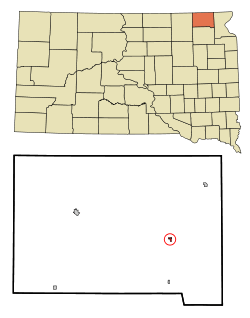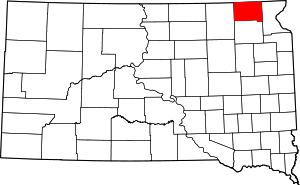Lake City, South Dakota
Lake City is a town in Marshall County, South Dakota, United States. The population was 51 at the 2010 census. Fort Sisseton Historic State Park, whose fort is listed on the National Register of Historic Places, is located nearby.[7][8]
Lake City, South Dakota | |
|---|---|
 Location in Marshall County and the state of South Dakota | |
| Coordinates: 45°43′26″N 97°24′50″W | |
| Country | United States |
| State | South Dakota |
| County | Marshall |
| Incorporated | 1914[1] |
| Area | |
| • Total | 0.23 sq mi (0.59 km2) |
| • Land | 0.22 sq mi (0.57 km2) |
| • Water | 0.01 sq mi (0.02 km2) |
| Elevation | 1,860 ft (567 m) |
| Population | |
| • Total | 51 |
| • Estimate (2018)[4] | 54 |
| • Density | 246.58/sq mi (95.00/km2) |
| Time zone | UTC-6 (Central (CST)) |
| • Summer (DST) | UTC-5 (CDT) |
| ZIP code | 57247 |
| Area code(s) | 605 |
| FIPS code | 46-35220[5] |
| GNIS feature ID | 1256013[6] |
Lake City was laid out in 1914, and so named for the many lakes in the area.[9]
Geography
Lake City is located at 45°43′26″N 97°24′50″W (45.723790, -97.413936).[10]
According to the United States Census Bureau, the town has a total area of 0.23 square miles (0.60 km2), of which, 0.22 square miles (0.57 km2) of it is land and 0.01 square miles (0.03 km2) is water.[11]
Lake City has been assigned the ZIP code 57247 and the FIPS place code 35220.
Demographics
| Historical population | |||
|---|---|---|---|
| Census | Pop. | %± | |
| 1930 | 162 | — | |
| 1940 | 168 | 3.7% | |
| 1950 | 110 | −34.5% | |
| 1960 | 81 | −26.4% | |
| 1970 | 44 | −45.7% | |
| 1980 | 46 | 4.5% | |
| 1990 | 43 | −6.5% | |
| 2000 | 47 | 9.3% | |
| 2010 | 51 | 8.5% | |
| Est. 2018 | 54 | [4] | 5.9% |
| U.S. Decennial Census[12] | |||
2010 census
As of the census[3] of 2010, there were 51 people, 19 households, and 15 families residing in the town. The population density was 231.8 inhabitants per square mile (89.5/km2). There were 29 housing units at an average density of 131.8 per square mile (50.9/km2). The racial makeup of the town was 82.4% White, 7.8% Native American, and 9.8% Asian.
There were 19 households of which 26.3% had children under the age of 18 living with them, 63.2% were married couples living together, 10.5% had a female householder with no husband present, 5.3% had a male householder with no wife present, and 21.1% were non-families. 21.1% of all households were made up of individuals and 5.3% had someone living alone who was 65 years of age or older. The average household size was 2.68 and the average family size was 3.13.
The median age in the town was 48.2 years. 23.5% of residents were under the age of 18; 7.9% were between the ages of 18 and 24; 17.7% were from 25 to 44; 39.2% were from 45 to 64; and 11.8% were 65 years of age or older. The gender makeup of the town was 58.8% male and 41.2% female.
2000 census
As of the census[5] of 2000, there were 47 people, 19 households, and 9 families residing in the town. The population density was 216.5 people per square mile (82.5/km²). There were 26 housing units at an average density of 119.8 per square mile (45.6/km²). The racial makeup of the town was 100.00% White.
There were 19 households out of which 36.8% had children under the age of 18 living with them, 47.4% were married couples living together, 5.3% had a female householder with no husband present, and 47.4% were non-families. 47.4% of all households were made up of individuals and 31.6% had someone living alone who was 65 years of age or older. The average household size was 2.47 and the average family size was 3.80.
In the town, the population was spread out with 36.2% under the age of 18, 23.4% from 25 to 44, 17.0% from 45 to 64, and 23.4% who were 65 years of age or older. The median age was 38 years. For every 100 females, there were 113.6 males. For every 100 females age 18 and over, there were 114.3 males.
The median income for a household in the town was $11,563, and the median income for a family was $63,125. Males had a median income of $38,750 versus $0 for females. The per capita income for the town was $14,036. There were no families and 8.0% of the population living below the poverty line, including no under eighteens and 22.2% of those over 64.
References
- "SD Towns" (PDF). South Dakota State Historical Society. Archived from the original (PDF) on 2010-02-10. Retrieved 2010-02-14.
- "2018 U.S. Gazetteer Files". United States Census Bureau. Retrieved February 22, 2020.
- "U.S. Census website". United States Census Bureau. Retrieved 2012-06-21.
- "Population and Housing Unit Estimates". United States Census Bureau. June 27, 2019. Retrieved June 4, 2019.
- "U.S. Census website". United States Census Bureau. Retrieved 2008-01-31.
- "US Board on Geographic Names". United States Geological Survey. 2007-10-25. Retrieved 2008-01-31.
- Thune, John R. "Fort Sisseton". Local Legacies. Library of Congress. Retrieved 2008-12-21.
- "Fort Sisseton Historic State Park". State of South Dakota. 2006. Retrieved 2010-02-18.
- Federal Writers' Project (1940). South Dakota place-names, v.1-3. University of South Dakota. p. 47.
- "US Gazetteer files: 2010, 2000, and 1990". United States Census Bureau. 2011-02-12. Retrieved 2011-04-23.
- "US Gazetteer files 2010". United States Census Bureau. Archived from the original on 2012-07-02. Retrieved 2012-06-21.
- "Census of Population and Housing". Census.gov. Retrieved June 4, 2015.
